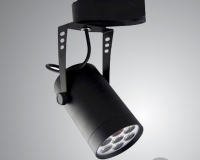Supermarket cold cases and wall refrigerators use about half the electricity load of a typical supermarket, making them big energy-saving targets for businesses operating on razor-thin margins.
Axiom Exergy says it has a simple way to slash those costs -- and keep refrigerated food from spoiling during a power outage in the bargain. Simply chill liquid in tanks at night, when grid power prices are low, and use that stored cool to take a load off the compressors and condensers that keep fridges running during hot afternoons when electricity prices are at their peak.
This week, the Berkeley, Calif.-based startup announced that its "Refrigeration Battery” is now ready to roll out to trial customers, in advance of a Series A round planned for later this year to scale up commercial production. So far it has raised seed funding of less than $1 million, and will be installing its first field unit at an unnamed Bay Area supermarket this summer, co-founder and president Amrit Robbins told me in an interview this week.

“We store refrigeration during off-peak hours to turn those big, dumb refrigeration systems into smart, cloud-connected energy storage assets at a really low cost, because the customer already owns half of it,” he said. Combining the off-peak to on-peak energy savings, the ability to avoid food spoilage during blackouts, and state-by-state energy efficiency and on-site generation incentives should allow the system to achieve a two- to four-year payback on investment, he added.
Axiom Exergy’s approach is similar to the way that thermal energy storage systems from Ice Energy, Calmac and other companies freeze liquid at night to augment the operation of rooftop air conditioners during the day. That technology has been in place for decades as large-scale district heating and cooling systems, and is starting to propagate across rooftops as a way for buildings and utilities to shift energy consumption during hot peak-power afternoons.
But to Robbins’ knowledge, this is the first attempt to target supermarket refrigeration with the concept. Axiom Exergy won a first-place prize at February’s startup pitching session at the Department of Energy’s ARPA-E program annual summit in February, indicating that the venture capitalists judging the session agree with that assessment.
Robbins got the idea for Axiom Exergy (“exergy” is the maximum possible useful work achievable by a system working at thermal equilibrium, by the way) as a co-lead for supermarket energy retrofit projects with big energy services provider Clark Energy Group. In that position, he spent several years working with big grocery chains, and “one thing that struck me is that half the energy in the supermarket is going to refrigeration systems. They’re these huge, monolithic energy sucks -- you can’t control them; they just run whenever the food is warm.”
And unlike deep-freeze units that can store energy by freezing food at colder temperatures, then allow them to drift slowly hotter during the day, refrigerators need to stay at a steady temperature at all times -- “you can’t freeze the lettuce,” as Robbins put it. That more or less forces supermarkets to keep the refrigerators running through times of day when commercial customers’ electricity prices can reach peaks as much as five times as high as off-peak, overnight prices.
Utility bills are part of a very small set of controllable costs for supermarkets, which run on margins that hover in the range of 1 percent to 2 percent. That means that saving about $20,000 on annual energy costs could equal selling an extra $1.4 million in groceries, he noted.
As for backup power, most grocery stores have diesel generators to keep their point-of-sale systems and emergency lighting on during a blackout, but “it’s nowhere big enough to run refrigeration,” he said. Preventing the food spoilage costs during blackouts could theoretically pay for the price of Axiom’s retrofit in a single go, he noted -- and at a price much lower than grid-scale backup batteries.
Axiom’s system also doesn’t alter the ongoing operations of a supermarket's compression and expansion-based refrigeration equipment, he added. That’s an important feature for supermarket chains that don’t want to do anything that might mess with their equipment warranties, or potentially expose their systems to failure if the retrofit equipment doesn’t work as promised.
“We take warm gas coming off the cases, put it through our process instead, and send back pressurized liquid,” he said. “We’re using the exact same piping, the same infrastructure. We simply enable the compressors and condensers to shut off during those peak hours.”
Axiom’s cloud-connected management platform will keep an eye on installed systems to catch breakdowns and inform supermarket maintenance crews, he said. That could also serve as the aggregation point to put these systems to use for broader utility demand response or load-shifting purposes, he noted. Supermarkets are one of the customer classes targeted by demand response providers like EnerNOC and energy services companies like Verisae and GridPoint, but largely for reducing lighting or air conditioning energy use.
Axiom has built a lab-scale unit that’s working right now, and has partnered with DOE’s National Renewable Energy Laboratory to vet its technology models and performance data, Robbins said. Its use of off-the-shelf components that have already been proven over decades of use across the world helps to lower technology risk, he noted.
The startup is also working on protecting its intellectual property, he said, and has hired Thomson Reuters to provide patentability reports on the startup’s key concepts. With a target market of 11 states with the incentive structures to allow quick payback, and a relatively simple idea that could serve what Axiom estimates as a $8.8 billion market, it’s likely that other companies may be eyeing similar concepts.







































